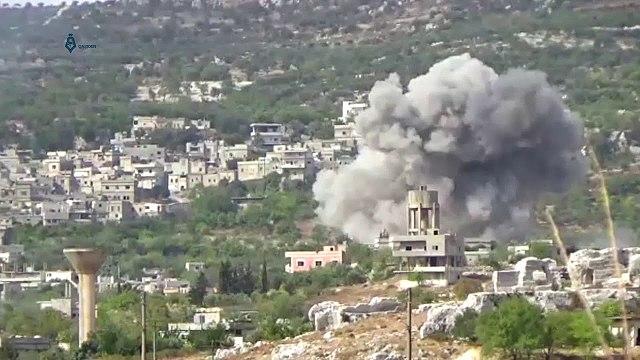
The United Nations and France have both recently warned of an impending humanitarian disaster in Syria’s Idlib province. Until now, the Syrian government has held off on launching an all-out offensive on the province. But recent development have reduced the cost of an attack, raising international concern.
In 2015, Russian air power and foreign ground troops turned the tide of the Syrian civil war in President Bashar al-Assad’s favour. With superior armaments and the influx of veteran fighters, the government retook many rebel-held areas, along with their populations and fighters antagonistic to Assad’s rule. To avoid a perpetual low-level insurgency, the government began to move the rebel-aligned populations to Idlib in the country’s northeast.
Such population transfers quickly became the norm. After retaking the rebel enclave in the old city of Homs in May 2014, the Syrian government offered some 1,400 civilians and fighters safe passage to Idlib.
This set the tone for nearly every settlement that followed. Once the government retook a rebel-held area, it allowed remaining rebel-aligned civilians and fighters to move to Idlib. In March 2018 alone, the province received some 10,000 fighters and civilians. At the same time, Assad filled the newly empty rebel-held areas with populations loyal to him, many of whom had fled from rebel militias elsewhere in Syria.
That rebel funnel to Idlib radically changed the demographics of the province. Before the civil war, the province was home to just over 1 million people. Most were Sunni but the province also had significant Christian and Druze communities. Over the course of the war, the population jumped to between 1.5 and 2.5 million. The increase resulted directly from the government’s transfers of Sunni civilians and fighters.
The new Sunni fighters, often aligned with extremist groups, quickly took power. They suppressed local minority groups, including through forced conversion and massacres. As Idlib’s Sunni population grew, many Druze and Christians fled to government-held areas.
Rival rebel groups in Idlib allied together early on in the conflict, but tensions quickly emerged. In 2015, for example, a coalition of rebels took control of the city of Idlib. Almost immediately afterwards, fighting broke out between the dominant factions. The perpetual drip of new fighters into the region under Assad’s population transfers fed the conflict.
The Syrian government has largely left Idlib alone, marking the province as one of its ‘de-escalation zones’. The government seems content to sit on its hands, letting the rebel factions in the province burn each other out before making a move. Turkey’s presence may also be preventing a concerted attack.
Turkey has been the most important backer of Idlib’s rebel groups. The province shares a border both with Turkey and Afrin province, the site of Turkey’s operation in Syria against Kurdish forces. Ankara has been supporting various Syrian militias since the rebel takeover of the province, and Turkish NGOs have been heavily involved in the region. Turkish troops are even stationed there under the ‘de-escalation zones’ agreement. Turkey has pressured Russia and Syria against attacking the province.
Ankara seemed to have two motives. First, the province acts as a buffer against refugee flows into Turkey. Secondly, the inflow of rebel fighters provides a pool of potential recruits for offensives against the Syrian Kurds trying to establish an autonomous region in Syria on the Turkish border.
But now that Turkey has taken Afrin and expelled Kurdish forces, its need for a rebel-held Idlib has been drastically reduced.
In securing Afrin, Turkey took a leaf from Assad’s playbook. It moved the Kurdish population out, replacing them with its own rebel fighters. Some 25,000 rebels participated in Turkey’s invasion of Afrin in January this year. Those fighters, as happened in Idlib, are pushing out the minority populations in the region.
Afrin’s population before the civil war was majority Kurdish, but included Yazidi, Christian, Turkmen and Arab Muslim populations. However, since Turkey’s takeover of Afrin more than 200,000 Kurds have fled the district. That number is approximately equal to the Afrin’s pre-civil war population. Yazidis, some of whom moved to Afrin to flee the genocide in Sinjar at the hands of ISIS, face forced conversion and death under Turkish rule. At the same time, the number of Sunnis in the district is increasing.
Ankara has been rapidly importing Sunni rebel groups and refugees into Afrin. In mid-April, Turkey began setting up ‘tent cities’ in Afrin for civilians fleeing Syrian forces in eastern Qalamoun. There are also reports of refugees from eastern Ghouta being moved into abandoned Kurdish houses. Turkey has also been relocating its proxies in Syria to Afrin.
Turkish control of Afrin district, and the transfer of its focus to that area, leaves Idlib vulnerable to a Syrian government offensive. Afrin can now act as a refugee buffer for Turkey. Furthermore Ankara has more direct control over the forces in Afrin, and doesn’t have to side with al-Qaeda backed militias as it did in Idlib.
Without Turkey’s de facto protection, Idlib is weak and under-protected. That leaves its population increasingly vulnerable to a Syrian government assault.